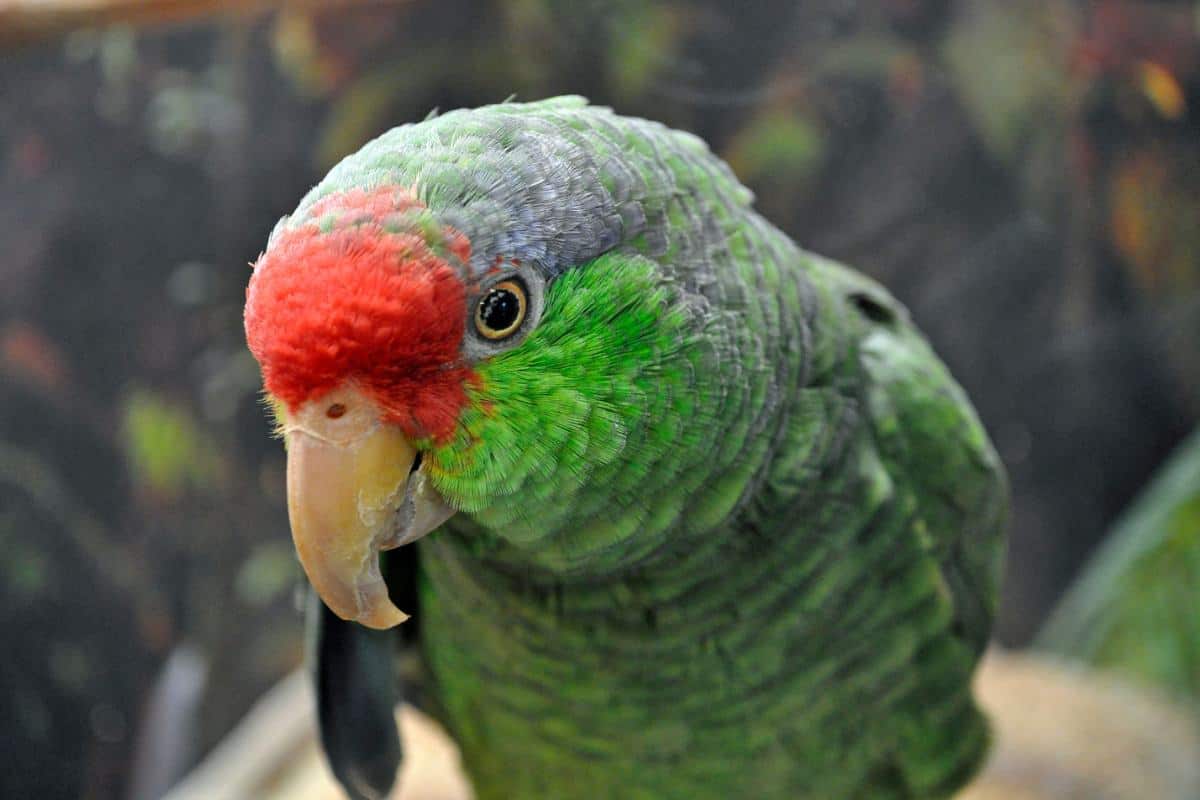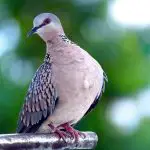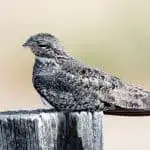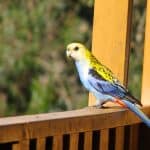Red-crowned amazonian parrot perched | image by Heather Paul via Flickr | CC BY-ND 2.0
The Red-crowned Amazon (Amazona viridigenalis), also known as the Green-cheeked Amazon or Mexican Red-headed Amazon, is a colorful and charismatic parrot species that is native to Mexico. With its striking green and red plumage and its playful and social nature, this parrot is a beloved sight in its natural habitat.
Although it is not a native species to Hawaii, Red-crowned Amazons have recently established themselves on the islands and are now considered naturalized (non-native) residents. In this article, we’ll explore the fascinating world of the Red-crowned Amazon and learn more about its recent establishment in Hawaii.
Common Name: Red-crowned Amazon
Scientific Name: (Amazona viridigenalis)| Size | Diet | Range in Hawaii | Status in Hawaii |
|---|---|---|---|
| 13 in. - 15 in. | fruits, seeds, nuts, flowers, and buds | O'ahu | Endangered |
Red-crowned Amazon
Appearance

The Red-crowned Parrot is a medium-sized parrot species known for its vibrant plumage and distinctive features. On average, it measures about 13 to 15 inches (33 to 38 centimeters) in length.
The Red-crowned Parrot has a predominantly green body, with shades ranging from bright emerald to olive green. It has a red patch on the crown of its head, which gives the species its name. The forehead and lores (the regions between the eyes and bill) are usually pale blue or bluish-white. Its beak is large, curved, and black, with a strong and hooked upper mandible that is characteristic of parrot species.
Additionally, the Red-crowned Parrot has a short, square-shaped tail and broad wings. The undersides of its wings are a darker shade of green, often contrasting with the brighter green on its body. It has dark brown eyes and its legs and feet are gray.
Juvenile Red-crowned Parrots have a similar appearance to adults, but their crown is not as fully red, and their plumage may be slightly duller. As they mature, the red crown intensifies, becoming more vibrant and prominent.
Diet
The Red-crowned Parrot has a varied diet that consists primarily of fruits, seeds, nuts, flowers, and buds. It is known to feed on a wide range of plant species, including fruits from trees such as figs, palms, and various tropical fruits. They also consume seeds and nuts from different plants, which provide them with essential nutrients and energy.
In addition to plant matter, Red-crowned Parrots may occasionally consume small amounts of insects, including ants, beetles, and their larvae. These insects supplement their diet with protein and other vital nutrients.
Being social birds, they often forage in small groups or flocks, which allows them to locate and exploit food resources more efficiently. They have strong beaks that enable them to crack open nuts and seeds, and they use their agile feet to hold and manipulate food items while eating.
The Red-crowned Parrot’s diet may vary depending on the availability of food sources in their habitat. They are adaptable and can adjust their feeding preferences to utilize different resources throughout the year.
Nesting
The Red-crowned Parrot builds its nests in cavities, typically within tree hollows. They prefer nesting in tall, mature trees with suitable cavities that provide a secure and sheltered environment for raising their young. However, due to habitat loss and competition for nesting sites, they may also utilize man-made structures such as nesting boxes or crevices in buildings.
During the breeding season, which varies depending on their geographic location, pairs of Red-crowned Parrots engage in courtship displays and vocalizations to establish and strengthen their bond. Once a pair forms, they work together to prepare the nest site. The female takes an active role in excavating the nesting cavity, while the male assists by bringing food and materials.
The nesting cavity is lined with wood chips, leaves, and other plant materials to create a comfortable and insulating environment for the eggs and hatchlings. The female typically lays a clutch of 2 to 4 eggs, which she incubates for about 24 to 28 days. Both parents take turns incubating the eggs and share the responsibilities of caring for the young.
After hatching, the chicks are altricial, meaning they are initially naked and helpless. They rely on their parents for warmth, protection, and feeding. Both parents participate in feeding the chicks by regurgitating partially digested food for them.
The nestling period for Red-crowned Parrots lasts around 8 to 10 weeks. As the chicks grow, they develop feathers and become more active and mobile within the nest. Eventually, they fledge and leave the nest, but they continue to rely on their parents for guidance and nourishment for some time.
Behavior
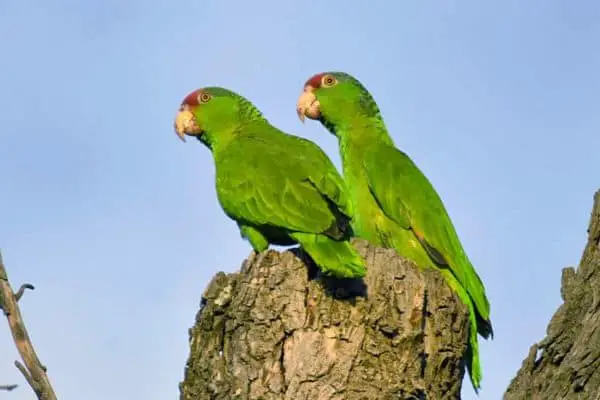
The Red-crowned Parrot exhibits a variety of interesting behaviors. These parrots are highly social and often form large flocks, ranging from a few individuals to hundreds of birds. They are known for their loud and raucous calls, which are used for communication within the flock.
Red-crowned Parrots are diurnal, meaning they are active during the day. They spend much of their time foraging for food, both in trees and on the ground. They have strong beaks that enable them to crack open nuts and seeds, and their agile feet are used to manipulate food items while eating.
These parrots are intelligent and curious, and they often engage in playful behavior. They may be seen climbing, hanging upside down, or engaging in acrobatic flights within the flock. Play serves both social and developmental purposes, helping them learn important skills and strengthen social bonds.
During the breeding season, Red-crowned Parrots engage in elaborate courtship displays. Males may perform aerial displays, fluttering their wings and making vocalizations to attract females. Pairs form strong bonds and engage in mutual preening and feeding as part of their pair bonding.
Communication is vital among Red-crowned Parrots. They use a variety of vocalizations, including calls, squawks, and screams, to communicate with each other. These vocalizations serve various purposes, such as warning others of danger, maintaining contact within the flock, or signaling their presence within their territory.
Habitat
The Red-crowned Parrot is native to the forests and woodlands of northeastern Mexico. Its habitat consists of semi-arid regions, including thorn forests, deciduous forests, and subtropical rainforests. These parrots are well adapted to a variety of habitats and can also be found in urban areas and agricultural landscapes.
Within their natural range, Red-crowned Parrots prefer areas with tall trees that provide suitable nesting sites and foraging opportunities. They are especially dependent on large, mature trees with cavities for nesting. These trees offer shelter and protection for the parrots and their offspring.
In urban areas, Red-crowned Parrots can adapt to parks, gardens, and even city neighborhoods where there are sufficient trees and vegetation. They may also utilize man-made structures such as nesting boxes or crevices in buildings as substitute nesting sites.
Access to water sources is important for Red-crowned Parrots, and they are often found near rivers, streams, and water bodies where they can drink and bathe. These parrots are also known to visit orchards, agricultural fields, and gardens in search of food, particularly fruits, seeds, nuts, and flowers.
Range
The Red-crowned Parrot has established a presence in Hawaii, particularly on the island of O’ahu. While native to the slopes of eastern Mexico, populations of this species have been introduced to various locations worldwide.
In Hawaii, the first sightings of Red-crowned Parrots occurred in the late 1960s near Kapiolani Park in Honolulu. Over time, their numbers increased and they expanded their range to areas such as Diamond Head, Makiki, Manoa Valleys, and potentially Momilani.
However, a significant shift in distribution occurred in the late 1980s when the flock relocated to the Pearl City area. The Pearl City flock of Red-crowned Parrots continued to grow, with high counts ranging from 26 to over 200 individuals at different times.
They primarily roosted in Eucalyptus trees along Manana and Wiamano ridges above Pearl City. The foraging range of these parrots included Pacific Palisades, mangroves at the Waiawa unit of Pearl Harbor National Wildlife Refuge, Aiea, Schofield Barracks, Waipahu, Mililani, and nearby valleys of the Ko’olau range.
Although there have been occasional sightings of a few Red-crowned Parrots in other parts of O’ahu and even on other Hawaiian islands, the main population remains concentrated in the Pearl City area. Some of these parrots may have escaped from captivity or were released, while others were the result of natural range expansion.
Conservation Status
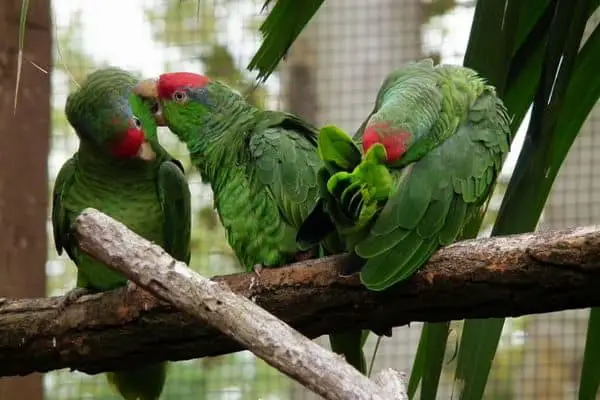
The Red-crowned Parrot is classified as Endangered according to the International Union for Conservation of Nature (IUCN). This species faces significant threats to its survival and has experienced a decline in population numbers.
One of the primary factors contributing to its endangered status is habitat loss and fragmentation. Deforestation, urbanization, and agricultural expansion have resulted in the destruction and degradation of the parrot’s natural habitat. The loss of suitable nesting sites and foraging areas has a detrimental impact on their population.
The illegal pet trade also poses a significant threat to the Red-crowned Parrot. These birds are highly sought after for their colorful plumage and playful nature, leading to widespread trapping and trade. The capture and removal of individuals from the wild further diminishes their population.
Interesting Facts
1. Sociable flocks
These parrots are highly social birds and often gather in large flocks consisting of hundreds of individuals.
2. Loud and distinct calls
Their vocalizations include screeches, squawks, and various other calls, which can be heard over long distances.
3. Agile flyers
Known for their acrobatic flight maneuvers, Red-crowned Parrots are skilled in quick turns and dives.
4. Strong beak for tough nuts
Equipped with a strong, hooked beak, they can crack open tough seeds and nuts.
5. Skilled mimics
They have the ability to mimic sounds, including human speech, and can learn words, phrases, and musical tunes.
Frequently Asked Questions
1. What is the lifespan of the Red-crowned Parrot?
The Red-crowned Parrot can live up to 20-30 years in the wild, depending on various factors such as habitat conditions, predation risks, and availability of food.
2. How do Red-crowned Parrots communicate?
Red-crowned Parrots communicate through various vocalizations, including squawks, screeches, and whistles. They use these calls to communicate within their flock, establish territories, and alert others to potential threats.
3. Are Red-crowned Parrots social birds?
Yes, Red-crowned Parrots are highly social birds that form large flocks. They engage in social interactions, such as grooming each other, flying in coordinated patterns, and vocalizing to communicate with their flock members.
4. Can Red-crowned Parrots be kept as pets?
While Red-crowned Parrots are popular in the pet trade, it is important to note that capturing and keeping them as pets contributes to their decline in the wild. It is best to support their conservation in their natural habitat rather than keeping them as pets.
